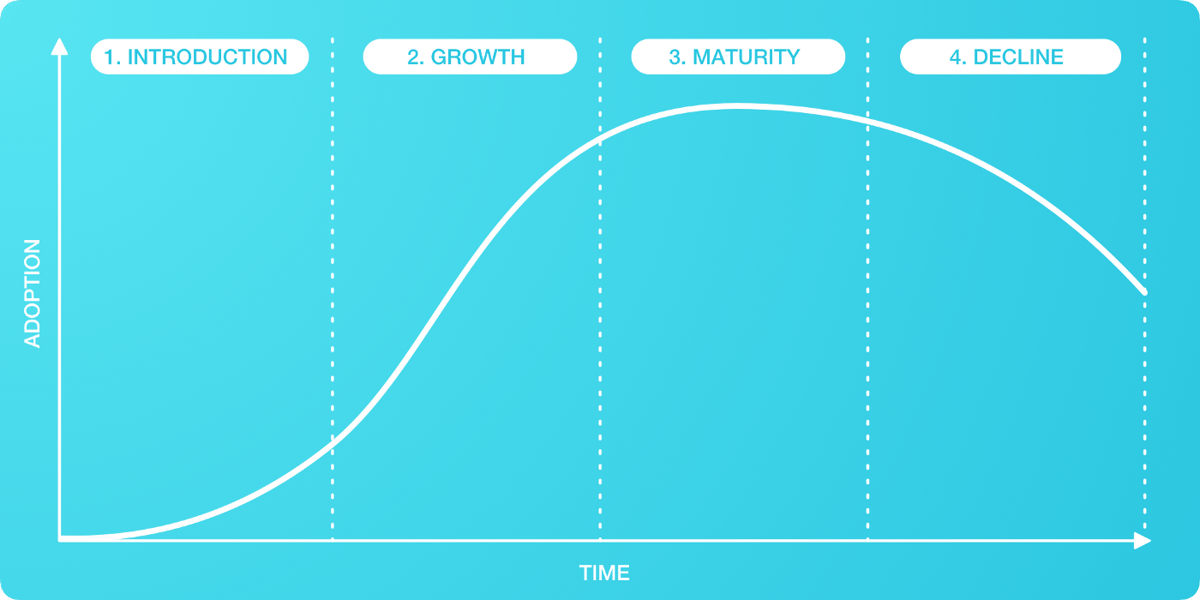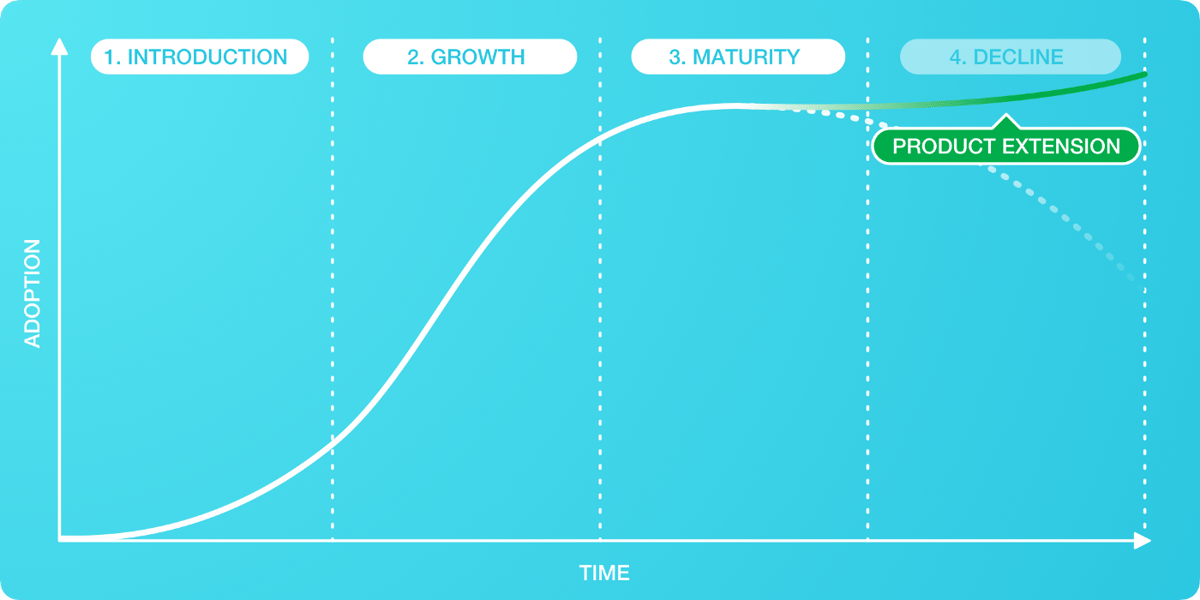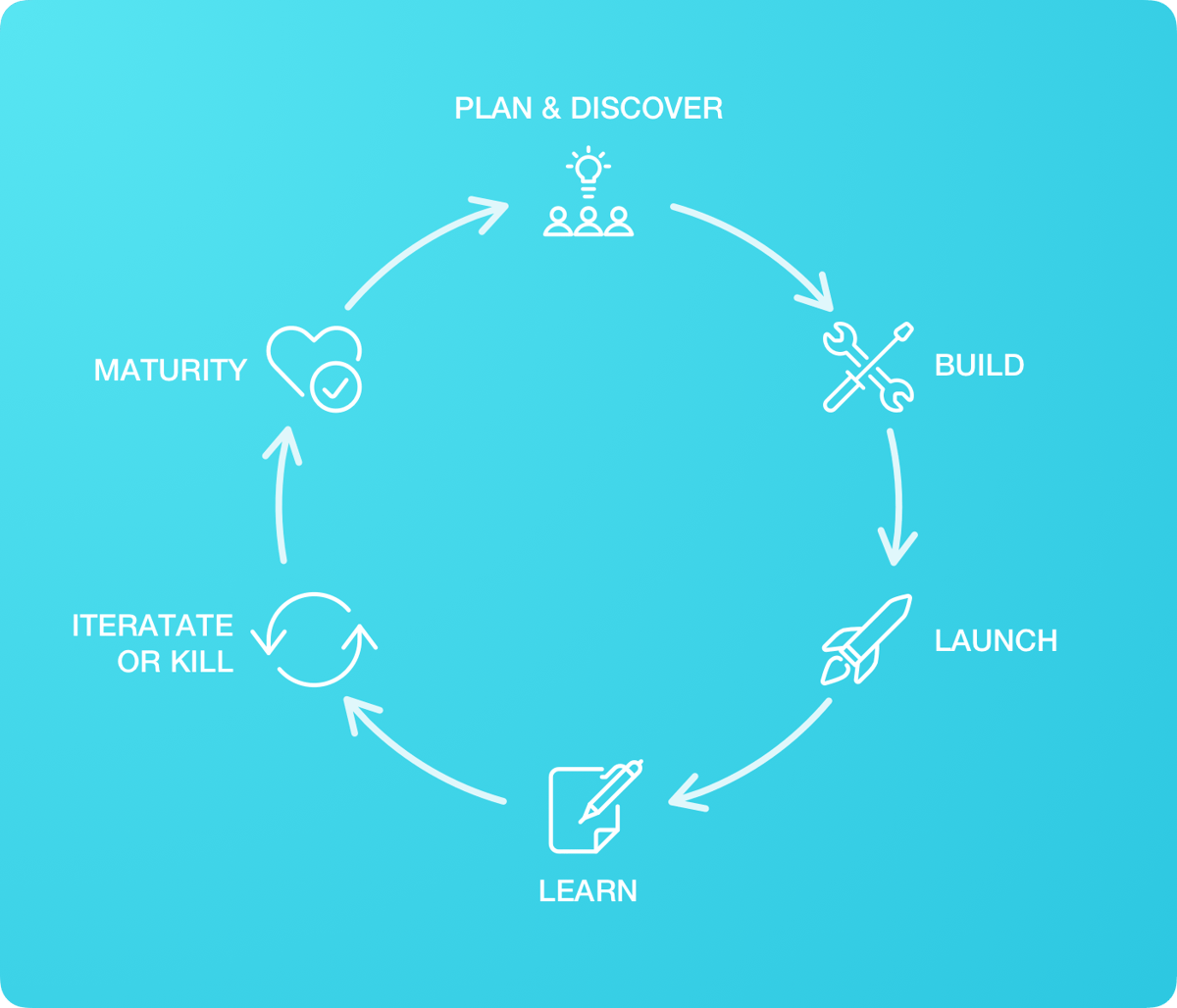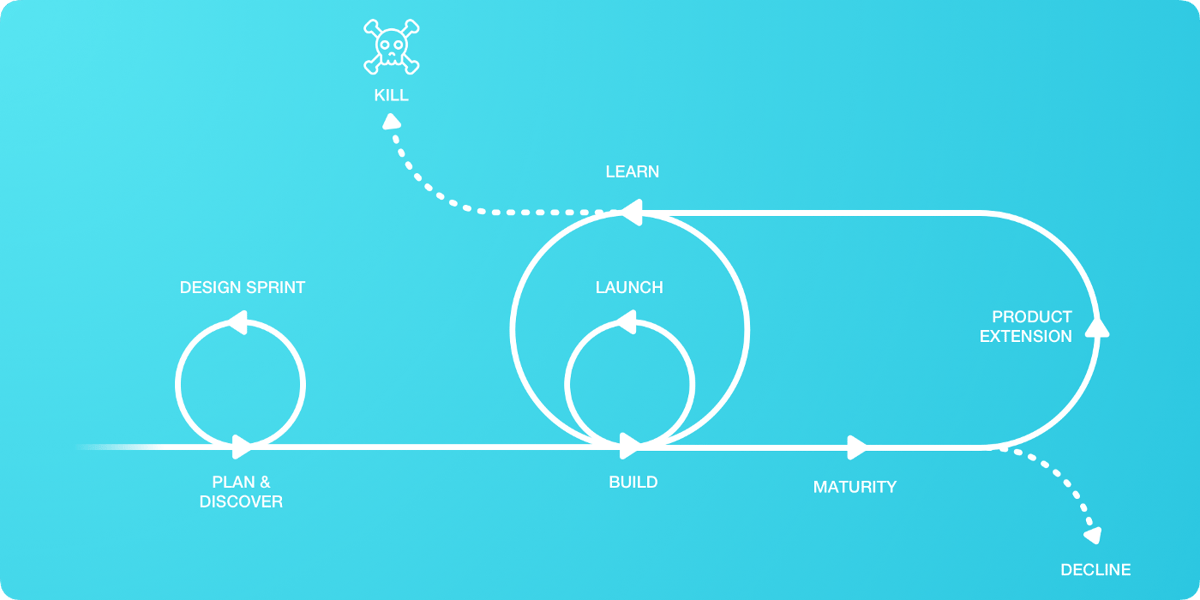A few years ago I wrote an article about Product Life Cycle & Product Development Cycle. Now that some time has passed I wanted to revisit this topic, and use all the comments, feedback and knowledge I have gained these past few years to discuss it from a fresh angle.
Along with a review of this subject, I will take a look at a few lessons I have learnt, including:
- The importance of team inclusion! (developers, designers & operations teams).
- The differences between B2B & B2C products.
- Continuous product discovery & agile software development.
- The benefits of releasing products or new features in several small iterations.
- Ways to drive innovation using methods such as Design Sprints.
Product Life Cycle
The Product Life Cycle is the set of commonly identified stages in the life of commercial products. The stages which a product cycles through during its lifespan are: Development, Introduction, Growth, Maturity and Decline.

The Product development stage is the first part of the Product Life Cycle. This stage is not only about building the product, it also includes carrying out the discovery work needed to research, testing and validate assumptions.
To learn more about product discovery and how to implement it throughout the product life cycle, take a look at continuous product discovery.
Market research, benchmarking, and competitor analysis are the main focus for research at this stage. These will help give an idea of the potential growth for the product, and support building a business case to validate the product.
Be sure to use customer interviews and create prototypes to gather feedback from potential customers and existing users. Their feedback after testing the product is vital to help you and your team understand customer problems and user needs.
As you carry out this research, remember to involve your other team members such as the designers and developers. This is important as it will:
- Keep the team aligned on what is already available in the market, and what are the user needs.
- Get their input on what can be done; different team members will take different approaches to all the lessons learnt the during research
- Create a sense of shared ownership and understanding into what needs to be built.
You should define what should be the first release or an MVP of the product with your team and spend time developing it, testing with potential users along the way. Once the development of the product is complete it is ready for the introduction stage.
Introduction
There are two different strategies you can use to introduce your product to consumers. You can use either a penetration strategy or a skimming strategy, and both are focused on how you price your product. The skimming strategy involves setting prices very high initially and then gradually reducing them over time. This is a good strategy to use if there are very few competitors for your product. Profits are high with this strategy but there is also a great deal of risk. If people don’t want to pay high prices you may lose out.
The second pricing strategy is a penetration strategy. In this case you set your prices very low at the launch and gradually increase them. This is a good strategy to use if there are many competitors who control a large portion of the market. Profits are not a concern under this strategy. The most important thing is to get your product known, and then you can focus on making money at a later time.
Growth
The Growth stage is where the market share of your product starts to grow. Often at this stage a large amount of money is spent on sales efforts and marketing. You want to focus your advertising campaigns at your target audience and existing customers, and sell the benefits of your products to them. There are several different routes you can take to advertise your product and what you choose will depend on your product, industry and advertising budget.
If you are in a business to consumer (B2C) market, your marketing and sales strategy are likely to be very different to a business to business (B2B) market.
When looking to reach consumers, social media platforms such as Facebook, Instagram, Youtube and Twitter provide targeted adverts. Other digital media options include using blogs or news websites to promote your product. You can also use more traditional advertising methods such as TV, radio, magazine or newspaper ads. The more traditional options are likely to be more costly than the digital ones.
When looking to reach B2B customers, using professional platforms such as LinkedIn would be more suitable. Furthermore, when looking into B2B you can use brochures, sales decks and promotional videos to explain and sell your product.
The best and cheapest way for your product to be advertised is through word-of-mouth, as promoted by your customers; this can only be done when your customers trust and enjoy your product. This is true for both B2C and B2B products.
When you are successful with your marketing and advertising strategies then you will see an increase in sales and in the number of users. After a period of a continuous increase in sales, eventually your share of the market will stabilise. Once you get to this point you will reach the Maturity stage of the product.
Maturity
The third stage in the Product Life Cycle is the Maturity stage. If your product completes the Introduction and Growth stages then it is likely to spend a great deal of time in the Maturity stage. After the Growth stage that had sharp increase sales and customer growth, during the Maturity stage your market share will gradually begin to stabilise.
When sales start to stabilise you will need to go back to the development stage. This involves analysing your current product and sales performance, exploring what can be improved, and what new opportunities could be available. This allows you to focus on innovation, finding ways to introduce new features to the product, cater to new market segments, or expand into new markets. The key to surviving this stage is to differentiate your product in the market and to innovate in order to help your company stay competitive. If you do not restart the product life cycle here, you are more than likely to reach the decline stage.
Decline
This is the stage where sales of your product begin to fall. Either everyone who wants it has bought your product or new, more innovative products have been created that replace yours. To stay competitive, and keep your market share, you will need to reassess your existing product and adapt or iterate its features. Ideally between the maturity and decline stage you would restart the product life cycle, to continue the success of your business. This is called Product Extension in the product lifecycle model.

Product Development Cycle
The product development cycle is a part of the product life cycle.

The product development cycle consists of the following stages: Plan & discover, Build, Launch, Learn, Iterate or Kill, Maturity.
Plan & Discover
The planning and discovery stage consists of all the work that needs to be done before any development commences. You want to make sure you have a valid business case and a solid, strategic plan to give your product the best chance of success.
To get an understanding of the market you are planning to enter, you will need to carry out market research, benchmarking, and competitive analysis. This research will need to answer important questions such as:
- Who are your target audience?
- Is there a need for the product? Can it be validated by surveys, customer interviews or consumer spending figures?
- Who are the competitors in the market and how will the product be able to compete with them? What is the potential market share for the product?
Your research should also look at cost of production and the potential price points of the product. Tools such as the business model canvas can help you structure the research. Having answers to these types of questions will be vital for your business case, by proving that there is a need for the product and there is profit to be made from it.
There are ways to give your planning and discovery a boost. Deciding to use design sprints to bring the right group of people together in a short period of time can be beneficial. Using inclusive methodologies will add alignment within your organisation and across the different teams, and you will be able to validate assumptions with real users.
To learn more about design sprints, see my article on how design sprints can scale up in an organisation.
As well as writing a business case, a Product Roadmap and Strategic Plan will also help to communicate what needs to be done for your product to succeed. These are both ‘live documents’ that are very likely to change over time depending on the market, your competitors and the business goals.
Build
In order to succeed in this stage, first you will need to collect all the lessons from the planning and discovery stage and share it with your team. By using planning methods that include various members of your team, the team will have a shared understanding of the customer demands, technical requirements and how the product can fit in the market.
Together with design and development, you will need to break down the plan into manageable releases, and document user stories for each feature. Once the different features have been thoroughly defined, they should be ranked by priority and difficulty, to establish which are most important and create an approximate completion time-frame.
The first product release will not contain all the features you or your stakeholders wish for, this is because you will need to compromise between features the first release must have, and the time to market. The first release is likely to be an MVP (minimum viable product) containing the core features necessary for the product to be of use to your customers and succeed in the market.
Following on from your MVP release, you will need to continue working with the design and development teams to carry on developing the product, adding new features and maintaining a working product. As you continue to develop the product you should return to the discovery and planning work to validate new product features, test new technologies and update your roadmap. Managing this will ensure a great product release and will enable you to evaluate the product and its features quickly once they are live.
Launch
As you complete the development of the first version of the product you will need to prepare to launch and release the product to market. This stage of product development is very similar to the Introduction stage of the Product Life Cycle.
You can let your target audience know that you are launching your product in a number of ways, such as press announcements, interviews, advertising or launch events. Physical launch events can be combined with digital events using tools such as Product Hunt.
For a successful product launch it is important to be aligned and work closely with your Sales and Operations teams in the weeks and months leading up to and following the launch. Once the product has launched, be sure to set up ways to track the usage and evaluate the performance of your product to prepare the assessment and evaluation stage that follows.
Learn
Assessing the product requires collecting metrics and analysing them to gather insight into the performance of the product. A few options for you to focus your assessment and analysis on can be A/B testing, challenging how to improve a return on investment, or testing what makes a returning customer.
Each feature of the product will need to be tested and evaluated to see if a feature is worth keeping and then either to be iterated on or be dropped from the product completely.
How do you evaluate the product? You can use Key Performance Indicators (KPIs) as metrics to measure the success of the product.
Key Metrics Measure For Product Success
- AARRR Metrics
- Acquisition
- Activation
- Retention
- Referral
- Revenue
To learn more about AARRR Metrics and startup metrics see Melanie Balke article on AARRR Framework.
Similar to the planning and discovery stage you will be using feedback from customers to evaluate the product. You will be able to learn more about how the product is serving their needs, what can be done to improve the product and what features need to be iterated on.
Iterate or Kill
Products should be monitored and maintained after launch. Using the lessons learnt from the assessment and evaluation stage, you and the team can make decisions on which parts of the product should be iterated on and which could be removed.
Features that prove not useful for the customer, and don’t generate engagement or revenue, should be removed. This should be done carefully and strategically, with customers being informed of the removal of features.
Maturity
For the features that are being kept, they will need to be iterated on and upgraded to ensure competitiveness.
This involves starting the Product Development Cycle all over again.
While starting the process again, your team will have become used to working well together, and will spend the majority of their time maintaining the product, fixing bugs and improving existing functionality.
Conclusion
Following the Product Development Cycle and Product Life Cycle will ensure your product is ready for market, and give it the best opportunity to succeed. by using discovery techniques, launching products in small iterations and continuously innovating.
Since writing the original article on Product Life Cycle and Product Development Cycle the big lessons I have learnt are:
- Use continuous discovery processes throughout the product development cycle. This will ensure you are aligned with your design and development teams, and you are regularly evaluating your assumptions with customers.
- Design Sprints and Design workshops are a great tool to use to drive innovation, solve complicated problems and validate with real customers.
- Be inclusive, use the expertise of the designers and developers on your team when planning what to build and how to split the product into releases. In addition make sure to align with other departments in the business who depend on the product for example: customer support, sales and marketing teams.
- Launch products or new features in small iterations in order to get to users quickly, measure and evaluate the impact of what has been created to help you decide on how to improve the product. This can be done using agile software methodologies such as Scrum or Kanban.
Bonus: How does it all fit together?
We created an additional model to explain how all the Product Development Cycle and Design Sprints fit together within the Product Life Cycle.



